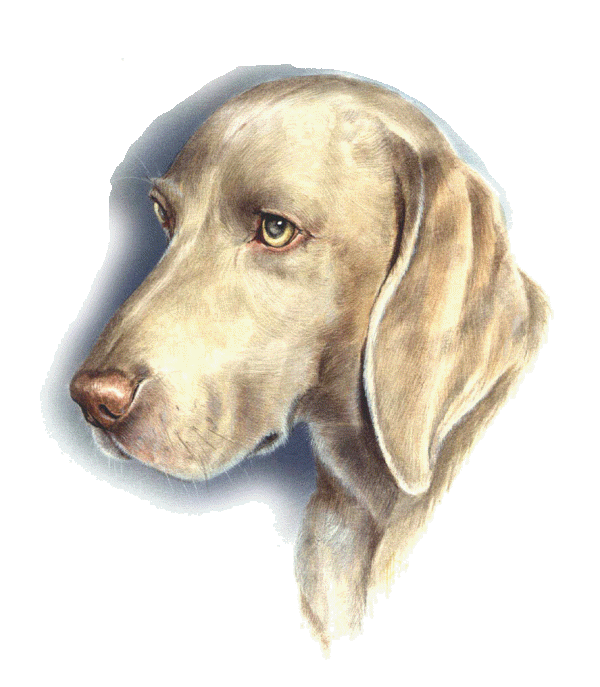


Weimaraners
2011
Ryanstock
Weimaraners
Straight Talk 3
The final part of three of the ĎStraight talkísí about the Kennel Club
and if you miss any then please go to the Library where you can catch up.
The Kennel Club have some crazy ideas, far too many to discuss in just two pages. I will try to confine my comments to two areas that I wish to cover in some detail. The development of new judges and the accredited breeders scheme. First I would like to make quite clear that I support the improvement in standards of judging, I also believe that breeding is the very lifeblood of any and every breed. Breeders should strive to maintain the very highest standards. I believe that they should do this to show dedication to their breed and for no other reason. Not all things that happened in the past were necessarily bad, some things worked quite successfully. Would-be judges would never have begun their judging career had they not have proved that they could either breed or show dogs to a satisfactory level. It is clear that even using this method judges would be in short supply at the higher level as the more experienced people either retired or left the world of judging . working to the old system, a judge would not be included on the judging list until they had completed their first appointment. Thereby allowing time for otherís to either complain or pass comment on their performance. It may not have been a perfect system but it was a system and it was workable and it did incentivise judges to improve their performance when carrying out their task.
Now it is possible to go on to a judging list without actually owning a dog. As long as you declare an interest you may be considered to undertake a judging appointment. It is perhaps unimaginable that you would rise to the top of the judging profession under these circumstances without undergoing some scrutiny, but not inconceivable that you would be allowed to judge at not just one but several small shows. With open shows looking to reduce costs and choosing more local judges. Why should you not become a judge without owning a dog? There is no specific reason, other than you need to earn the respect of your peers in order to gain good entries. So to understand how a dog should be constructed and how a dog should move and what impact good or bad construction would have on the effect of movement, it does seem pertinent to fully understand your particular breed. It also seems relevant to have gone through a selection process at some time in order for you to be able to make decisions that you can validate. The selection of the dog that you would wish to show. To develop the ability to see and understand the breed type, the conformation, the balance and ultimately the overall dog and its qualities seem very relevant prior to undertaking a series of judging appointments. When you breed dogs then you stand or fall on the reputation of your stock and itís consistency, this too should play an important part in providing quality judges. Once you are on the judging list then you can begin to establish the numbers required to move to the next level. At the same time you can attend and complete the necessary seminars. If at this point you are unsure of canine basic anatomy you could download this from the Internet. As I saw at one breed seminar if you keep it securely tucked away, on the day of the seminar you and others present could memorise the various points on the dog and tick the appropriate boxes when asked. An obvious flaw in the process. If you are attending a hands-on seminar then you can hope that you will be given the opportunity to examine dogs that are excellent, very good or very mediocre, this should allow others to establish your credibility as a judge. Many seminars however are unable to get the balance of dogs to meet the expectations of the day and sometimes there is little to choose between the five dogs present. So in terms of learning to judge there is little value in the exercise and why certain dogs excel over others will still be mystery to these prospective judges. I and many others believe that there must be some knowledge of the breed, some understanding of itís function and at least a minimum knowledge of construction and movement before stepping into a ring and becoming a judge and being accepted onto a judging list. I think even the Kennel Club believe that we need to see improvements within the judging ranks but so far their ideas do not reflect this.
The latest idea is that before a judge awards CCís for the first time in the gundog section they must attend a field trial. I wonder if anyone from the KC has attended a field trial, Iím sure someone has , but not necessarily the person that came up with this idea. If they had then they would realise that the dogs work so far in front that spectators have a job to see the dogs at work.. Even if the prospective judge is positioned up with the field trial judge what would they see. In our breed there are an average of 17 competitors in any one year, whilst their dogs may work with competence they and examples from other breeds may not always present the finer points of the breed standards. Some of the setter and pointer breeds work on the moors and are much more wide ranging in their work and so viewing dogs specifically would be even more problematic, they are also usually much finer in build than those in the showring which confuses the issue even more. Which is the correct type and construction ? The same question of type and construction would apply to Labradors and some Spaniels. This has become a common talking point between those who have worked their dogs and viewed field trials out of interest for many years. Whilst there is a genuine need for the education and a constant review of the necessary training of judges it should be based on a system that can be measured to ensure consistent improvements. Many judges do wish to continue to learn and improve their abilities, but there are still those who believe if they can just get their first CC appointment they are safe. Safe as long as they do not do anything too controversial.
The old system needed to change but there were some elements that should have been kept. We should not change over completely from a knowledge based system to a process of gaining knowledge as we go along and hopefully we will all get there in the end. Because if we do not insist on the knowledge being firmly ingrained in the new breed of judges , then all we get are people with a knowledge of how to succeed at seminars and how to pass a paper qualification. When the Kennel Club begins to ease back on the need to produce money from everything it does, it could just realise that within itís core business it should begin to focus on joining the organisation together. Utilising judges and their knowledge within breeds to provide good feedback to a center of excellence within the Kennel Club that could react quickly to changes occurring within breeds and immediately involve breeders and breed clubs to respond to any adverse problems. Of course that would mean having an open line and open door policy within the Kennel Club so that all parties could communicate effectively with each other in dealing with specific issues. PAGE 2